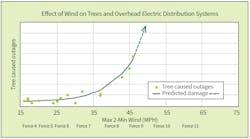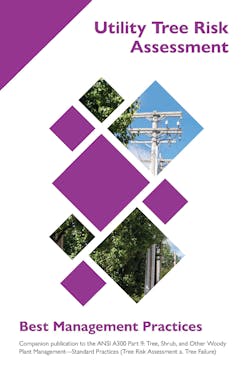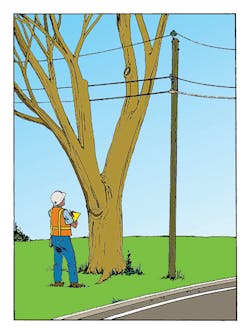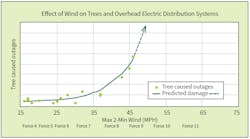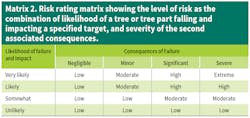New BMPs Guide Utilities in Assessing Tree Risks
Utility vegetation managers are responsible for risk assessment in a large population of trees across the utility forest. To develop risk assessment practices specific to the utility vegetation management industry, the International Society of Arboriculture (ISA) recently published the new Best Management Practices — Utility Tree Risk Assessment (UTRA BMP). This project was conceived and authorized by the Utility Arborist Association (UAA) in late 2015.
Tree risk assessment is increasingly recognized as an important component of utility vegetation management (UVM) programs. This has not always been the case. In 2016, UAA conducted a survey of tree risk assessment practices in the UVM industry as part of this project. The survey (N=40) included large investor-owned utilities (50%) as well as municipal utilities, public utility districts and electric cooperatives. The survey revealed four in 10 utilities did not have a tree risk assessment program separate from routine preventive vegetation maintenance work and 85% of respondents had no deliberate tree risk assessment program focused on the distribution system. Only 43% of the utilities that had a formal tree risk assessment program indicated it was based on application of ANSI A300 Part 9 (Tree Risk Assessment).
More recently, utilities have had an increased awareness of the true underlying reason for UVM activities — to reduce the likelihood of adverse events from tree-conductor conflicts — rather than to simply maintain tree-conductor clearances. Clearance is one step removed from reliability. Tree and branch failures are what create risk.
The new UTRA BMP is the resulting work product of a committee of subject matter experts who worked through a dozen drafts before achieving consensus. The document aligns with ANSI A300 Part 9 (2016), ISA’s 2017 Best Management Practices – Tree Risk Assessment, second edition (TRA BMP), and ISA’s Tree Risk Assessment Qualifications (TRAQ) program. The new BMP also describes the kinds of deliberate decisions that must be made and has a bias against implied or default decisions on roles and responsibilities. Utility vegetation managers are encouraged to adapt the practices in this new reference guide.
Why a Utility-Specific ISA BMP?
The utility industry’s application of tree risk assessment practices differs from that of other commercial and consulting arborists working with clients who own individual or small groups of landscape trees. In contrast, UTRA considers trees not owned or controlled by the utility. While utility tree risk assessors consider individual trees, risk is assessed and managed across very large populations of trees in proximity to overhead electric lines, which compose the utility forest. UTRA practices also differ from those of general arboriculture as the focus is on trees on both developed urban sites as well as in rural forested areas. As a result, tree risk assessment efforts by utilities typically rely on Level 1 Limited Visual Assessment.
Another difference is UTRA focuses exclusively on risk to the utility target. Utility infrastructure is a fixed target and present at the time the tree is being assessed. In contrast, general tree risk assessors may consider a variety of transient targets that may not be on the site when the tree is being assessed. There is no expectation the utility tree risk assessor will consider other potential targets.
Defining a Best Practice
It is important to define what constitutes a best practice. For the UTRA BMP, practices were determined by consensus and several criteria were used to draft it. First, best practices are not bare minimums: The intent is to raise the bar to a reasonable level, while recognizing resource constraints. The practices identified as best also are in actual use by leading UVM programs; they are not just hypothetical.
Practices that have been included in the new BMP are intended to reflect long-term value and strike a balance between economic efficiency and risk. The point of codifying best practices is to provide guidance on what provides the best value when a range of relevant variables are considered. It also is important to point out, like industry standards, the BMP provides general guidance on processes and the elements of tree risk assessment, while enabling individual utility vegetation managers the latitude to adopt and adapt them in a manner that best addresses local conditions, approaches to risk management and risk tolerance.
Parties to the UTRA Process
The three parties to the utility tree risk assessment process are the utility vegetation manager, utility tree risk assessor and utility line clearance arborist. The BMP defines the role of each within the overall process.
The utility vegetation manager’s role is to specify the scope of the UTRA effort. The BMP emphasizes that the utility vegetation manager makes deliberate decisions and clearly defines the scope of, and expectations for, UTRA work completed in the field. This is because, in many cases, the utility tree risk assessor who is doing the actual assessment of the site, target and trees may be under contract to the utility.
The BMP also recognizes that tree crews, doing line clearance maintenance, perform risk assessments as a safe work practice (ANSI Z133) and that this also is an opportunity to generally assess the structural integrity of a tree in more detail.
Considering Weather Conditions
The second edition TRA BMP includes three classes of weather, each with different implications for tree failure. Each also is included in the UTRA BMP:
- Normal weather is what might be expected to occur within the specified risk assessment time frame and is considered by the risk assessor.
- In contrast, extreme weather is not expected to occur within the period over which risk is being assessed.
- Abnormally extreme weather is unpredictable, occurs infrequently and clearly is not considered during a typical risk assessment assignment.
The new BMP also includes an expanded discussion of the force of wind on trees, tree failure rates and the resulting effect on overhead utility systems. A new appendix describing application of the Beaufort wind scale to describe the effect of wind in utility forests has been included in the BMP.
Utilities have no expectation of eliminating all risk to an overhead electric utility system, because of tree failure that can occur during adverse weather. Some level of tree and tree part failure must be expected and accepted. The new BMP includes references to the IEEE 1366 (2012) standard on reliability indices and recognizes that conditions during major event days (MED) “exceed reasonable design and/or operational limits of the electric power system.” An acknowledgment also refers to force majeure, or acts of God, as circumstances beyond what are considered normal for the local site or beyond the control of the utility vegetation manager or tree risk assessor.
Limitations to UTRA and Residual Risk
The new BMP addresses the relatively high percentage of trees that fail yet display no obvious indicators of being structurally compromised and predisposed to failure. Post-incident inspections of trees that failed and struck lines often find that they do not exhibit symptoms, which would have been apparent prior to failure and suggested they presented any elevated risk.
As such, a level of residual risk follows preventive vegetation maintenance work, including work focused on tree risk assessment. Said another way, it is impossible to completely protect an overhead electrical system in wooded areas from all tree risk exposure. Some level of risk must be acknowledged for society to experience the benefits trees provide. The only plausible course of action is for utilities to reasonably minimize the risk of tree strikes rather than to eliminate all tree.
UTRA Process
The UTRA BMP follows the same qualitative risk assessment process used in ISA’s other BMP. Those familiar with the ISA’s general TRA BMP will recognize the method, matrices and definitions used. However, there are some important changes and amplifications.
First, the order in which the UTRA characterizes exposure to a line strike has been reversed. The first consideration is the likelihood of a target (line) strike if the tree being assessed were to fail. If the tree is unlikely to strike an overhead line, it presents little or no risk, and the utility tree risk assessor moves on. The new BMP also recognizes differences in the criticality of various elements of utility infrastructure by allowing adjustment in the target zone.
Assessing all trees tall enough to strike a line may be appropriate for the most critical lines and areas of highest risk, while the area being assessed may be narrower for many classes of distribution lines and in areas of relatively low risk. Only when there is an unacceptable probability of a line strike is the likelihood of the tree failing within the specified time period considered. Assessment of the likelihood of tree failure closely follows ISA’s companion BMP as well as the TRAQ program.
The second significant departure from ISA’s general TRA BMP is breaking down consideration of the consequences of a tree strike into two components: direct and indirect. Direct consequences of a line strike are defined in terms of impact on energy delivery infrastructure and generally can be assessed by a utility tree risk assessor while on-site. This involves considering the level of damage likely to occur to the target (line) as the result of impact by the tree or tree part at risk of failing.
In contrast, indirect consequences are defined in terms of the types of things that could happen as a result of damage to the utility system. Indirect consequences consider potential adverse outcomes and could include the cost to restore and repair the damage, the societal impact of loss of service, the public’s exposure to abnormal conditions and other kinds of loss. A key point is, while the UTRA BMP provides some high-level ideas that may be help to define a range of indirect consequences, the consequences ultimately are defined by the utility vegetation manager and should be relevant to a specific utility system and level of risk tolerance.
The new UTRA BMP joins other important references intended to provide utility vegetation managers with concepts that can be adapted and incorporated into a UVM program. These references provide constructs, but it is up to utility vegetation managers to develop program-specific specifications and practices that address conditions relevant to the power system they manage.
About the Author
John W. Goodfellow
John W. Goodfellow has 40 years of experience in the utility industry and is a leading authority on utility vegetation management and reliability. He currently manages an active portfolio of vegetation management-related research projects and serves as chair of the Right-of-Way Stewardship Council’s technical advisory committee, which established accreditation requirements for integrated vegetation management on electric transmission and pipeline systems in North America. He is the lead author of the new International Society of Arboriculture Best Management Practice: Utility Tree Risk Assessment (2019).
